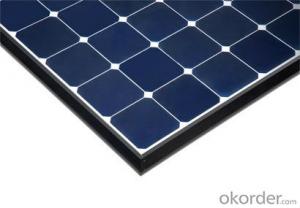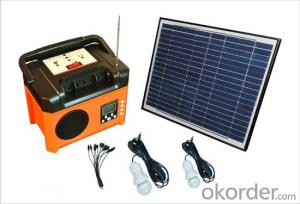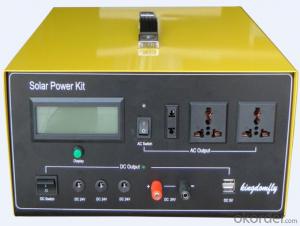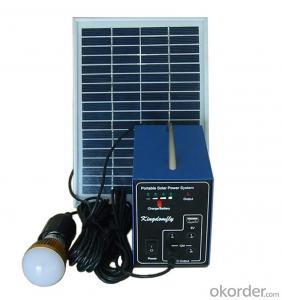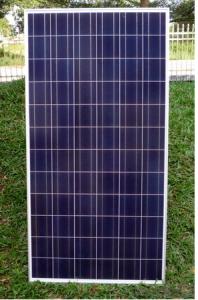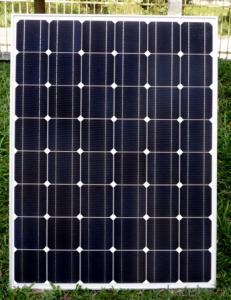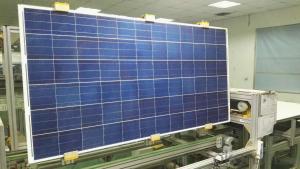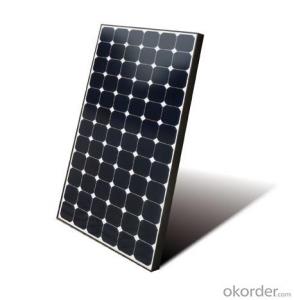Aditya Solar Energy Systems CNBM Poly 100W Off Grid Solar System with 10 Years Warranty
- Loading Port:
- Shanghai
- Payment Terms:
- TT OR LC
- Min Order Qty:
- 100 watt
- Supply Capability:
- 1000 watt/month
OKorder Service Pledge
OKorder Financial Service
You Might Also Like
Specification
CNBM Poly 100W Off Grid Solar Sytem with 10 Years Warranty
Product description
Electrical power can be generated on-site with renewable energy sources such as solar (particularly with photovoltaics), wind, micro hydro, geothermal; with a generator or Micro combined heat and power with adequate fuel reserves. Such a system is called a stand-alone power system. In addition, it is possible to simply eliminate electric power such as in Old Order Amish and Old Order Mennonitecommunities.
A recent concept design by Eric Wichman shows a multi-family community, which combines all of these technologies into one self-sufficient neighborhood. To grow the community you simply add neighborhoods using the same model as the first. A self-sustained community reduces its impact on the environment by controlling its waste and carbon footprint
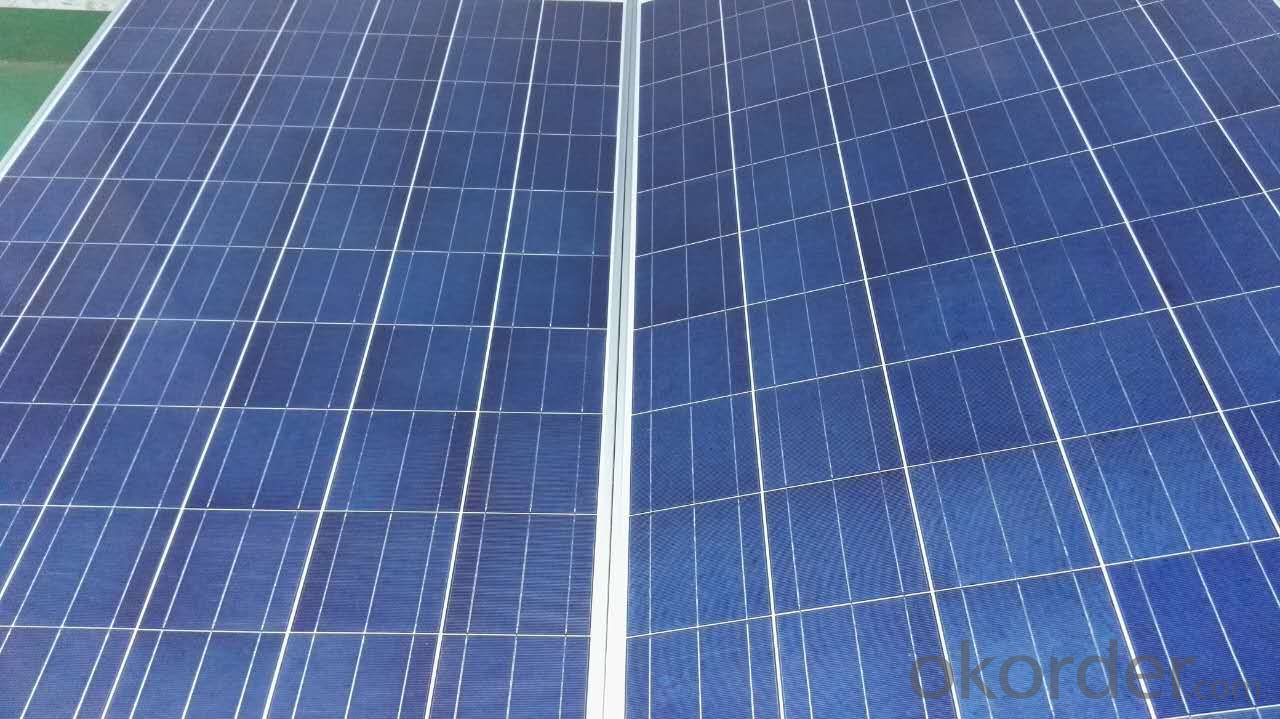
Application
Residential
Commercial
Industrial
Feature
Off-the-grid homes are autonomous; they do not rely on municipal water supply, sewer, natural gas, electrical power grid, or similar utility services. A true off-grid house is able to operate completely independently of all traditional public utility services. The idea has been recently popularized by certain celebrities including Ed Begley, Jr.[3] who stars in the Living with Ed[4] television show on the Home & Garden Television (HGTV) network. Actress Daryl Hannah promotes off-grid living and constructed her home in Colorado according to those principles, as does survival expert and Dual Survival co-star Cody Lundin,[5] who lives in a self-designed, passive solar earth house in the high-desert wilderness of Northern Arizona, collecting rainwater, composting waste, and paying nothing for utilities.[6][7]
Packaging
With carton and box
- Q: Can a solar energy system be installed on a building with a clay tile roof?
- Yes, a solar energy system can be installed on a building with a clay tile roof. Clay tile roofs, although more challenging to work with compared to other roofing materials, can still accommodate solar panels. The installation process may require additional care and expertise to ensure the clay tiles are not damaged during the installation and that the solar panels are securely attached to the roof. It is essential to work with experienced solar installers who have knowledge and experience in working with clay tile roofs to ensure a successful installation.
- Q: How does the installation of solar panels affect the roof's warranty?
- The installation of solar panels typically does not void the roof's warranty. However, it is important to consult with the roofing manufacturer and installer to ensure that the installation process does not breach any warranty conditions.
- Q: How do solar energy systems impact the stability of the electricity grid?
- Solar energy systems can have both positive and negative impacts on the stability of the electricity grid. On one hand, solar panels generate clean and renewable energy, reducing the reliance on fossil fuels and lowering greenhouse gas emissions. This diversification of the energy mix can enhance the stability and resilience of the grid. However, the intermittent nature of solar power, influenced by weather conditions and daylight availability, can create challenges for grid operators in maintaining a constant supply-demand balance. Proper integration of solar energy systems with advanced grid management technologies and energy storage solutions is crucial to mitigate these potential destabilizing effects.
- Q: Can solar energy systems be used in areas with limited access to solar energy publications and resources?
- Yes, solar energy systems can be used in areas with limited access to solar energy publications and resources. While access to information and resources can be helpful, it is not a prerequisite for utilizing solar energy systems. Basic knowledge and understanding of the technology, combined with technical expertise, can enable the installation and maintenance of solar energy systems. Additionally, local communities can seek support from experts, organizations, or government agencies to bridge the knowledge gap and ensure successful implementation of solar energy systems in such areas.
- Q: Can solar energy systems be used in powering theme parks or water parks?
- Yes, solar energy systems can definitely be used to power theme parks or water parks. Solar energy is a clean and renewable source of power that can provide a sustainable and cost-effective solution for meeting the energy needs of these establishments. Theme parks and water parks require a significant amount of electricity to operate attractions, lighting, water pumps, and other facilities. Installing solar panels can help reduce their reliance on conventional energy sources and decrease their carbon footprint. The large open spaces available in theme parks and water parks are ideal for installing solar panels, which can be mounted on rooftops, carports, or ground-mounted arrays. Solar energy systems can generate electricity by converting sunlight into usable energy through photovoltaic (PV) panels. These panels can be integrated into the infrastructure of the park discreetly and efficiently. The energy generated during the day can be used immediately to power rides, lighting, and other equipment, and any excess energy can be stored in batteries for use during periods of low sunlight or at night. Furthermore, solar energy systems can provide a reliable source of power and reduce the vulnerability of theme parks and water parks to power outages or disruptions in the grid. This is particularly important in areas prone to extreme weather events. By incorporating backup battery storage systems, solar energy can provide a constant and uninterrupted power supply even during emergencies. In addition to the environmental and reliability benefits, solar energy systems can also provide long-term cost savings for theme parks and water parks. While the initial installation cost might be higher, the operational costs are significantly reduced as the sun provides free and abundant energy. Over time, the savings on electricity bills can offset the initial investment, resulting in substantial cost savings for the park's owners. Overall, solar energy systems have the potential to revolutionize the power supply of theme parks and water parks. By harnessing the sun's energy, these establishments can not only reduce their environmental impact but also achieve long-term cost savings and enhanced energy reliability.
- Q: What government incentives are available for solar energy systems?
- There are several government incentives available for solar energy systems. These include federal tax credits, state and local rebates, grants, and loan programs. Additionally, some utility companies offer net metering programs that allow solar system owners to earn credits for excess electricity they generate. These incentives aim to encourage the adoption of solar energy and make it more affordable for individuals and businesses to install solar systems.
- Q: Can solar energy systems be used in areas with frequent hurricanes?
- Yes, solar energy systems can be used in areas with frequent hurricanes. While it is true that hurricanes can cause damage to solar panels and other components of solar energy systems, there are measures that can be taken to mitigate these risks. Firstly, the design and installation of solar energy systems in hurricane-prone areas can be done to withstand high winds. This includes using stronger mounting systems, reinforced frames, and secure anchoring techniques. Additionally, the orientation and tilt angle of the panels can be optimized to minimize wind resistance. Furthermore, regular maintenance and inspections can help identify any potential issues or damage to the system before a hurricane hits. This allows for timely repairs or replacements, ensuring the system remains functional and safe during extreme weather events. In the event of a hurricane, it is important to have emergency procedures in place to secure the solar panels and other components. This can involve temporarily removing the panels and securing them indoors or utilizing protective covers to shield them from debris. Moreover, the use of microinverters or power optimizers in solar energy systems can enhance their resilience in hurricane-prone areas. These technologies allow each solar panel to operate independently, mitigating the impact of any damage to a single panel and preventing the entire system from shutting down. Lastly, solar energy systems can also contribute to the resilience of communities during and after hurricanes. With proper battery storage, solar systems can provide backup power during power outages, allowing essential services to continue operating and providing electricity for critical needs such as lighting, refrigeration, and medical equipment. Overall, while precautions need to be taken to ensure the durability and functionality of solar energy systems in hurricane-prone areas, they can be effectively used to harness clean and renewable energy even in the face of frequent hurricanes.
- Q: What is the role of charge controllers in solar energy systems?
- The role of charge controllers in solar energy systems is to regulate and control the flow of electricity between the solar panels and the batteries. They ensure that the batteries are charged efficiently and prevent overcharging or damage to the batteries. Additionally, charge controllers help optimize the performance and lifespan of the batteries by providing protection against over-discharging and excessive voltage.
- Q: How do solar energy systems impact the reduction of greenhouse gas emissions?
- Solar energy systems have a significant impact on the reduction of greenhouse gas emissions. Unlike fossil fuels, solar energy systems produce electricity without emitting any greenhouse gases such as carbon dioxide (CO2) or methane (CH4) during operation. This is because solar panels harness the sun's energy to generate electricity, which is a clean and renewable source of power. By replacing traditional energy sources like coal or natural gas, solar energy systems mitigate the need for burning fossil fuels, which are the primary sources of greenhouse gas emissions. Fossil fuels release vast amounts of CO2 and other pollutants into the atmosphere when burned for electricity generation. In contrast, solar energy is generated through photovoltaic (PV) panels or solar thermal collectors, which do not produce any emissions. Moreover, solar energy systems can also indirectly contribute to reducing greenhouse gas emissions. When solar power is integrated into the electricity grid, it helps to displace electricity generated from fossil fuel power plants. This displacement reduces the overall demand for fossil fuels, leading to a decrease in greenhouse gas emissions from the power sector. Furthermore, solar energy systems can be deployed on a wide range of scales, from small residential installations to large utility-scale solar farms. This versatility allows solar power to be harnessed in both urban and rural areas, providing clean energy solutions to diverse communities. By encouraging the adoption of solar energy systems, governments and organizations can accelerate the transition to a low-carbon economy and mitigate the harmful effects of climate change. In conclusion, solar energy systems play a crucial role in reducing greenhouse gas emissions by producing clean electricity without any emissions during operation. By displacing fossil fuel-based electricity generation and promoting the use of renewable energy, solar power contributes significantly to mitigating climate change and creating a sustainable future.
- Q: How do solar energy systems impact the grid?
- Solar energy systems have a positive impact on the grid by reducing the overall demand for electricity from traditional sources. They generate clean and renewable energy, which can be fed back into the grid, reducing the reliance on fossil fuel-based power plants. This helps in reducing greenhouse gas emissions and promoting a more sustainable energy mix. However, the intermittent nature of solar power can create challenges for grid operators in managing fluctuations in supply and demand, requiring efficient grid management and energy storage solutions.
Send your message to us
Aditya Solar Energy Systems CNBM Poly 100W Off Grid Solar System with 10 Years Warranty
- Loading Port:
- Shanghai
- Payment Terms:
- TT OR LC
- Min Order Qty:
- 100 watt
- Supply Capability:
- 1000 watt/month
OKorder Service Pledge
OKorder Financial Service
Similar products
Hot products
Hot Searches
Related keywords
